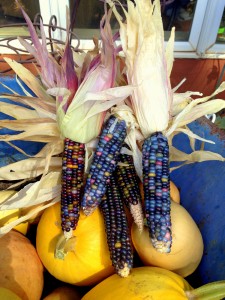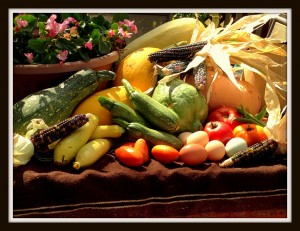 She considereth a field and buyeth it, with the fruit of her hands she planteth a vineyard. She looketh well to the ways of her household and eateth not the bread of idleness. Her children arise up and call her blessed; her husband also, and he praiseth her. — Proverbs 31:16, 27, 28
She considereth a field and buyeth it, with the fruit of her hands she planteth a vineyard. She looketh well to the ways of her household and eateth not the bread of idleness. Her children arise up and call her blessed; her husband also, and he praiseth her. — Proverbs 31:16, 27, 28
I dream. I’m sitting on wicker furniture with a friend in an apple orchard. We are bathed in moonlight. The boughs hang heavily and fragrant with massed ivory blossoms. I’m uneasy because its autumn and we’ve already had two killing frosts. We talk quietly but in the back of my mind I know there is work to be done. I awake to find Sue already at work harvesting her garden.
Sue is picking the prolific spaghetti squash. The lemon yellow football fruit produce well year after year. She puts them into the wheel barrow with the Hubbard squash that are warty and chalkboard green. There are only a few of the Italian squash that look like small pumpkins forged of rose gold. There’s a single example of “Cave Squash” grown from seed that was found in an old clay pot in a cave in Utah in the ’30s. There’s Mexican Grey squash, it looks like zucchini but it has tiny streaks of white against the dark green like a meteor shower in the Amazon. This is my favorite one to bread and fry because of its delicate buttery flavor. The winter squash will go on shelves in our cellar-like basement.
Sue uses a spading fork to dig the late potatoes. She winnows the dark soil with her fingers and places anything larger than a marble in the bucket. The plump russets are white inside and crisp as an apple. She digs into the row of sweet potatoes. Sweet potatoes love heat and she is growing them in Flagstaff’s cool soil as an experiment. Ten hills yield 12 plump tubers and a few fingerlings, a modest harvest of sweet, dense gold teeming with rich flavor.
The tomatoes glow like little solar engines. They strike me as rare wines. I love to sit back at the table and watch Sue line up three or four tomatoes on a cutting board. “This is an Earl of Sedgwick from seed your brother Sam sent.” I feel the tart splash against my tongue and taste hints of berries. “… and this is the Cherokee Purple.” The flesh is a deep plum color and a full sweetness lingers in my mouth. I search for a vocabulary to explain how these precious fruit explode in my nose and mouth. The unripe tomatoes that aren’t canned now are placed on dimpled cardboard trays in boxes in the cool basement to ripen slowly.
I’m overwhelmed by the lavish color that saturates these humble vegetables. I hold a bouquet of carrots, wine dark, ruby red and classic pumpkin orange, their tops flaring into a fretted spray of mint green. The last of the pole beans dance their finale in graceful arcs, flashes of green through gray wilted foliage. Sue’s rosy dahlias stand tall, untouched by the frost. Lo que es un milagro!
We want non-GMO cornmeal for cornbread. This has become harder and more expensive to find with 90 percent of the U.S. corn crop being GMO, so Sue grew a patch of Northstine Dent corn, a traditional field variety. The husks are left on the cob and they will dry for several weeks before the grains are removed and stored in a five gallon bucket. We grind all our grains; wheat, corn, rye as needed for the freshest, best-tasting bread. We ate the last of the sweet corn several weeks ago. We also filled many bags with fresh grains we cut off the cob and froze for winter meals.
There was only room for a bathtub size patch of the intriguing Glass Gem Corn. The multi-colored ears inclined to a range of darker green, yellow and blue grains, although there were ears with the milky pastels and bright jelly bean colors that are so surprising to me. Several stalks “volunteered” in the field corn patch and produced their jeweled ears beside their common yellow brothers.
Sue has made batches of salt brine pickles in an old crock. Just cucumbers, water, sea salt, dill weed, garlic and a few grape leaves to preserve color and crispness. These are old-fashioned dill pickles of the sort that once filled a big barrel in the corner of every deli and general store—crunchy and juicy. We’ve had success at making sauerkraut also. Finely chopped cabbage is packed into a crock with salt and allowed to ferment in its own brine for several weeks to several months. The resulting kraut is big and robust and would make your German grandma smile.
 Every autumn evening my wife brings in whatever’s perfectly ripe from her garden and plans a meal. The menu couldn’t be more varied if she were working her way through a Julia Child cookbook. I smell the wonderful odors wafting from the kitchen and listen to the comforting clatter of pans and dishes. Then Sue presents another meal, beautiful in its simplicity and amazing in its taste and quality. I’m not sure what I did to be included in her circle of attention and care, but I count myself to be most blessed among men.
Every autumn evening my wife brings in whatever’s perfectly ripe from her garden and plans a meal. The menu couldn’t be more varied if she were working her way through a Julia Child cookbook. I smell the wonderful odors wafting from the kitchen and listen to the comforting clatter of pans and dishes. Then Sue presents another meal, beautiful in its simplicity and amazing in its taste and quality. I’m not sure what I did to be included in her circle of attention and care, but I count myself to be most blessed among men.

